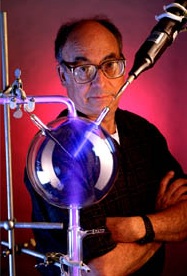Miller–Urey experiment
Miller–Urey Experiment
The Miller–Urey experiment was a groundbreaking scientific experiment that tested the chemical origins of life on Earth. Conducted in 1952 by Stanley Miller under the supervision of Harold Urey at the University of Chicago, it was designed to assess the chemical conditions of the early Earth's atmosphere and its potential for abiogenesis—the process by which life arises naturally from non-living matter.
Background[edit | edit source]
In the early 20th century, scientists debated the conditions present on the prebiotic Earth and how these conditions might have contributed to the origin of life. The prevailing theory, known as the Oparin-Haldane hypothesis, proposed by Alexander Oparin and J.B.S. Haldane independently, suggested that Earth's early atmosphere was reducing, containing methane (CH4), ammonia (NH3), water (H2O), and hydrogen (H2), and that under such conditions, organic compounds necessary for life could have formed spontaneously.
Experiment[edit | edit source]
The Miller–Urey experiment simulated the conditions of the early Earth's atmosphere by filling a sterile glass apparatus with a mixture of methane, ammonia, water vapor, and hydrogen. The apparatus also included two electrodes to simulate lightning, a common event on the early Earth. The mixture was heated to evaporate water, creating a water cycle within the apparatus, and an electric current was passed through the gas to simulate lightning. After a week, Miller analyzed the contents of the apparatus and found that several organic compounds had formed, including amino acids, which are the building blocks of proteins and vital to life.
Findings[edit | edit source]
The experiment demonstrated that organic compounds necessary for life could be synthesized from simple molecules under conditions thought to resemble those of the early Earth. This was a significant step forward in understanding the origin of life, suggesting that the organic molecules necessary for life could have formed naturally on the early Earth.
Impact[edit | edit source]
The Miller–Urey experiment had a profound impact on the field of astrobiology and the study of the origin of life. It provided the first experimental evidence supporting the theory that the organic compounds essential for life could form naturally on the early Earth. The experiment has been repeated and modified in various ways, confirming and extending the original findings. It has also inspired numerous other experiments and research into the origins of life, both on Earth and elsewhere in the universe.
Criticism and Reevaluation[edit | edit source]
Over the years, the Miller–Urey experiment has faced criticism and reevaluation. Some scientists have argued that the early Earth's atmosphere might have been less reducing than Miller and Urey assumed, which would affect the likelihood of such reactions occurring naturally. Despite these criticisms, the experiment remains a landmark study in the field of origin of life research.
Legacy[edit | edit source]
The Miller–Urey experiment is considered a classic experiment in the study of the origin of life. It has inspired generations of scientists to explore the chemical origins of life on Earth and elsewhere in the universe. The experiment's findings continue to influence research in geochemistry, astrobiology, and the study of exoplanets and their potential for hosting life.
Search WikiMD
Ad.Tired of being Overweight? Try W8MD's physician weight loss program.
Semaglutide (Ozempic / Wegovy and Tirzepatide (Mounjaro / Zepbound) available.
Advertise on WikiMD
|
WikiMD's Wellness Encyclopedia |
| Let Food Be Thy Medicine Medicine Thy Food - Hippocrates |
Translate this page: - East Asian
中文,
日本,
한국어,
South Asian
हिन्दी,
தமிழ்,
తెలుగు,
Urdu,
ಕನ್ನಡ,
Southeast Asian
Indonesian,
Vietnamese,
Thai,
မြန်မာဘာသာ,
বাংলা
European
español,
Deutsch,
français,
Greek,
português do Brasil,
polski,
română,
русский,
Nederlands,
norsk,
svenska,
suomi,
Italian
Middle Eastern & African
عربى,
Turkish,
Persian,
Hebrew,
Afrikaans,
isiZulu,
Kiswahili,
Other
Bulgarian,
Hungarian,
Czech,
Swedish,
മലയാളം,
मराठी,
ਪੰਜਾਬੀ,
ગુજરાતી,
Portuguese,
Ukrainian
Medical Disclaimer: WikiMD is not a substitute for professional medical advice. The information on WikiMD is provided as an information resource only, may be incorrect, outdated or misleading, and is not to be used or relied on for any diagnostic or treatment purposes. Please consult your health care provider before making any healthcare decisions or for guidance about a specific medical condition. WikiMD expressly disclaims responsibility, and shall have no liability, for any damages, loss, injury, or liability whatsoever suffered as a result of your reliance on the information contained in this site. By visiting this site you agree to the foregoing terms and conditions, which may from time to time be changed or supplemented by WikiMD. If you do not agree to the foregoing terms and conditions, you should not enter or use this site. See full disclaimer.
Credits:Most images are courtesy of Wikimedia commons, and templates, categories Wikipedia, licensed under CC BY SA or similar.
Contributors: Prab R. Tumpati, MD



